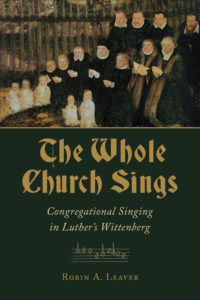
The Whole Church Sings
Robin A. Leaver. The Whole Church Sings: Congregational Singing in Luther’s Wittenberg, Grand Rapids: Eerdmans, 2017, 206 pp. $22.
Reviewed by Nicholas Hopman
Nearly 500 years after Martin Luther first reformed the Mass, we are living through a golden age of scholarship on Luther’s work in music and liturgy and its effects on early Lutheranism. The dean of scholars in this genre is Robin Leaver, Professor Emeritus at Westminster Choir College (Princeton, NJ). In The Whole Church Sings, Leaver corrects the erroneous scholarly consensus that no hymnal with new vernacular Lutheran congregational hymns existed in Wittenberg until 1529. This would have left Wittenberg itself far behind other early Lutheran municipalities in terms of congregational singing. Leaver argues that two hymnals of congregational hymns, no longer extant, were published in Wittenberg between late 1524 and early 1526.
Leaver’s argument is largely based on the well-documented existence of a single copy of a Wittenberg hymnal for laypeople (“fur die layen”) printed in 1526, which Leaver argues was from the third edition of hymnals published for use in Wittenberg. According to Leaver, scholars have simply not thought through clearly and deeply enough the implications of this 1526 hymnal. After reading Leaver’s book, the previous scholarly consensus seems odd. Indeed, after correcting his own previous endorsement of the mistaken premise Leaver writes, “the view that Wittenberg was somewhat slow in taking up hymnody has always puzzled me, and it seemed rather strange that the earliest extant witnesses to the early development of such singing did not emanate directly from Wittenberg” (162).
If Leaver’s convincing speculation based on extant evidence is correct, the first Wittenberg hymnal with strophic vernacular hymns was published in 1524 or shortly thereafter, the same year as Johann Walter’s Wittenberg Chorgesangbuch, which was four-part settings for choral (choir) singing. This means that right from the start Luther and the Wittenberg reformers believed that choir music, including singing in Latin, and congregational singing should fill Lutheran churches in harmonious cooperation.
While no one will ever be able to know exactly how well the first Lutherans sang the new hymns, Leaver presents interesting historical evidence from church orders that shows the reformers were concerned with teaching the hymns to the congregation. The orders mention that the schoolboy choir should lead and help the congregation in singing the new vernacular hymns (133), but many also instruct preachers, often accompanied by the sexton, to lead the congregation’s singing from the pulpit (134–39). It seems plausible that this technique achieved at least a reasonable degree of success among the musical people of the sixteenth century.
Leaver shows the interrelated nature of the development of Luther’s German Mass, Psalter, and Bible, with the text of Luther’s Bible appearing directly in new Lutheran biblical canticles, and the various texts evolving with one another. One comes away from The Whole Church Sings, along with Leaver’s magisterial Luther’s Liturgical Music: Principles and Implications, Lutheran Quarterly Books (Grand Rapids: Eerdmans, 2007), understanding that Luther was a reformational, poetical, musical, and liturgical maestro rather than the liturgical hack he was painted to be by Yngve Brilioth and many other liturgical scholars, who slavishly followed/follow Brilioth’s assessment. After reading Leaver’s books on Luther and the Wittenberg reform of worship, one wonders why so many Lutherans have been convinced to prefer the often unevangelical premises of the liturgical renewal movement of the twentieth century rather than Luther’s authentically evangelical virtuosic worship.
Before getting to his central thesis on hymnals in Wittenberg, Leaver describes the contemporary state of music and church music in the early 1520s, showing that Luther’s musical reforms were in no way iconoclastic. He gives an excellent summary of The Wittenberg Movement led by Andreas Carlstadt in 1521–1522. Carlstadt attacked all forms of music in the church except for congregational singing in unison (41). This could hardly be further away from Luther’s theological and liturgical understanding of music as presented by Leaver. Leaver’s support for James Preus’s thesis (36), that Luther and Carlstadt only disagreed on the process of reform, is mistaken. Carlos Eire’s claim that Luther and Carlstadt’s disagreement went down to the deepest bedrocks of their respective theological beliefs actually dovetails nicely with Leaver’s analysis of the musical differences between Carlstadt and Luther.[1]
Leaver’s central argument concerning the early Wittenberg hymnals is concise and convincing. His clear writing style and his interesting subject matter make the whole book well worth reading. This book also includes very helpful appendices documenting early Lutheran hymns and hymnals as well as a significant bibliography and helpful indices.
In the coming 500th anniversary of the flowering of Lutheran hymnody in 2023 and beyond, Lutheran pastors have a golden opportunity to teach the great hymns of the Wittenberg Reformation. They should read Leaver’s books in preparation for these events.
Nicholas Hopman, PhD Student, Princeton Theological Seminary
[1] Carlos Eire, War Against the Idols: The Reformation of Worship from Erasmus to Calvin (Cambridge: Cambridge University Press, 1986).
